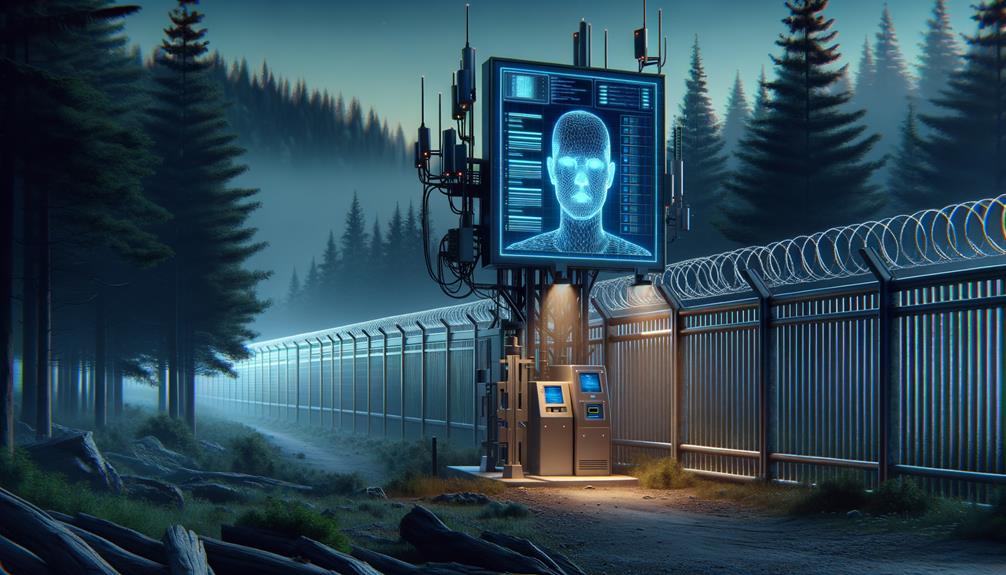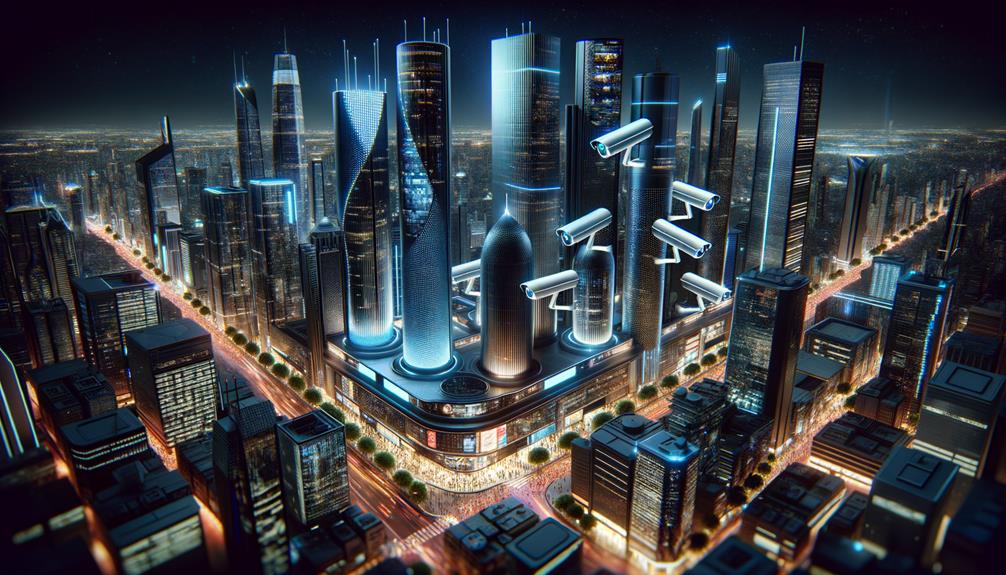Facial recognition is becoming a go-to option for perimeter security due to its many benefits. For example, it boosts efficiency by quickly identifying individuals without the need for physical credentials. It also enhances security by precisely verifying identities and improving situational awareness for prompt response to incidents. Moreover, it streamlines operations and reduces the risk of unauthorized access. Integrating facial recognition with current access control systems and optimizing camera placement and lighting conditions are essential for precise recognition. If you are interested in discovering more about how facial recognition transforms perimeter security, keep digging.
Key Takeaways
- Facial recognition technology quickly identifies individuals, reducing operational overhead and enhancing efficiency.
- It guarantees access for authorized personnel without physical credentials, offering unparalleled convenience.
- Facial recognition provides real-time monitoring and analysis, accurately verifying identities to reduce unauthorized access.
- It integrates seamlessly with existing access control systems and video monitoring infrastructure for robust perimeter security.
- The technology mitigates risks and safeguards assets effectively, ensuring that only authorized personnel enter secured areas.
Enhancing Efficiency and Convenience
Enhancing Efficiency and Convenience
When it comes to securing perimeters, how can facial recognition technology streamline access control and enhance operational effectiveness?
One of the primary benefits of facial recognition in perimeter security is its ability to boost efficiency by quickly identifying individuals, thereby reducing manual checks and wait times. This technology guarantees that authorized personnel can access secure areas seamlessly without the need for physical credentials, which not only saves time but also eliminates the risk of lost, stolen, or forgotten identification.
Furthermore, the convenience offered by facial recognition technology is unparalleled, as users can simply walk up to a camera and gain access without having to fumble with cards or remember passwords. This automated process markedly reduces the operational overhead of issuing and managing physical credentials.
Additionally, facial recognition systems can be integrated with existing access control systems, making it even easier to implement and maintain. Overall, the implementation of facial recognition technology at the perimeter markedly improves operational efficiency while enhancing security measures.
Strengthening Security and Safety
Implementing facial recognition technology at the perimeter not only streamlines access control but also strengthens security and safety by providing fail-safe methods of identifying and uncovering unauthorized individuals. By leveraging advanced computer vision and AI algorithms, these systems can detect and alert security personnel to potential security breaches, enhancing the overall safety within the perimeter.
Here are three key ways facial recognition systems bolster security measures:
- Proactive Monitoring: Facial recognition technology provides real-time monitoring and analysis, enabling security teams to anticipate and respond to security threats before they materialize.
- Identity Verification: Facial recognition systems accurately verify identities, markedly reducing the likelihood of unauthorized access and misusing credentials.
- Enhanced Situational Awareness: The technology furnishes security personnel with timely and accurate information, empowering them to make informed decisions and respond promptly to security incidents.
Facial recognition technology effectively fortifies perimeter security, ensuring that only authorized personnel have access to secured areas. By embracing this technology, organizations can substantially bolster their security posture, mitigate risks, and safeguard their assets.
Integration With Perimeter Systems
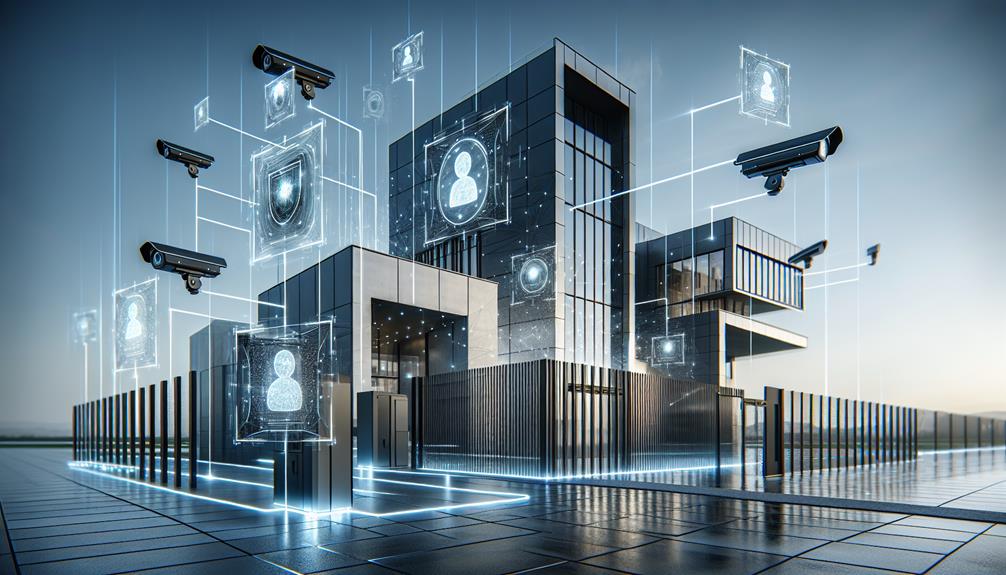
Facial recognition technology can be seamlessly integrated with existing perimeter security systems for enhanced access control. Integration allows for real-time identification and tracking of individuals entering or exiting a secured area.
Camera Alignment and Placement
To maximize seamless integration of facial recognition technology with perimeter security systems, strategically align and place cameras to capture accurate facial features, focusing on key entry points, gates, and high-traffic areas. This optimizes that facial features are captured from the best angles, enhancing the accuracy of recognition.
Proper camera alignment and placement are critical components of an effective perimeter security setup. Effective camera placement involves three essential considerations:
- Height and Angle: Mount cameras at ideal heights and angles to capture facial features directly, avoiding obstructions like hats or shadows.
- Field of View: Ensure that cameras have a wide enough field of view to capture faces clearly without any distortion.
- Resolution and Lighting: Use high-resolution cameras and subsidies lighting at entry points to maximize that all faces are well-illuminated for enhanced recognition.
Following these guidelines optimizes that cameras and facial recognition systems work in harmony, providing reliable and accurate identification at all points of entry and egress.
Lighting Conditions for Accuracy
Effective facial recognition depends on adequate lighting, and integrating facial recognition systems with perimeter security lighting guarantees that precise identification remains feasible in a wide range of lighting conditions. This integration guarantees that the conditions for strong facial recognition are met, which is crucial in improving security. In various environments, the impact of lighting on facial recognition can be significant, as detailed below:
| Lighting Conditions | Facial Recognition Performance |
|---|---|
| Low-Light Conditions | Improved Accuracy |
| Nighttime | Precise Identification |
| Variating Environmental Lighting | Consistent Performance |
| Optimized Perimeter Lighting | Maximized Facial Recognition |
Advanced algorithms in facial recognition systems can adapt to different lighting environments, making sure to maintain high levels of precision. Infrared capabilities in facial recognition cameras also guarantee precise identification even in low-light or nighttime conditions. By integrating facial recognition with perimeter lighting systems, we can ensure that best lighting conditions are always maintained, resulting in enhanced security and efficiency. This fusion of cutting-edge technologies ultimately leads to a strong perimeter security system.
Challenges in Face Recognition
I encounter a range of hurdles when relying on face recognition to bolster perimeter security, including inaccuracies stemming from changes in lighting, facial expressions, or angle variations. This technology isn't immune to errors that can compromise its effectiveness.
Key Challenges
- Environmental Factors: Weather conditions and background noise can greatly reduce recognition accuracy.
- Crowded Environments: Recognizing faces in dynamic environments with multiple subjects in motion remains a notable challenge.
- Invasive Surveillance: Concerns about data breaches and the invasion of privacy continue to trouble facial recognition systems.
To guarantee the integrity of perimeter security, it's essential to address these challenges. This includes securing data privacy and protection, managing false positives and false negatives, and optimizing the technology for diverse lighting conditions and dynamic settings.
Use Cases and Future Trends

The integration of facial recognition systems into perimeter security is opening up a myriad of new use cases and technological advancements, promising to enhance access control, real-time threat detection, and operational efficiency.
One of the most important advantages of facial recognition in perimeter security is its ability to accurately identify authorized personnel entering restricted areas, streamlining visitor management processes and bolstering overall security.
Future trends suggest the integration of facial recognition with AI technology for real-time threat detection and proactive measures, ensuring that security personnel can respond swiftly to potential incidents. Moreover, these systems can monitor individuals moving around restricted areas, providing enhanced situational awareness.
The incorporation of facial recognition into perimeter security can greatly reduce the risk of unauthorized access and improve response times. By integrating with video surveillance systems, facial recognition technology can create a detailed security ecosystem, ensuring seamless surveillance and swift reaction to potential threats.
As we look forward to the future, emerging applications of facial recognition technology will certainly reshape the landscape of perimeter security, making it faster, more efficient, and more secure.
Corporate and Private Implementations
As we move on to corporate and private implementations, facial recognition technology has greatly improved access control in these environments.
By integrating biometric surveillance systems, companies can swiftly and accurately identify individuals attempting to enter restricted areas, thereby providing an additional layer of security.
In this situation, facial recognition access offers a robust means of securing corporate and private properties with precision and efficiency.
Facial Recognition Access
Companies are increasingly adopting facial recognition access systems in both corporate and private settings to strengthen their security measures. This technology has revolutionized access control by leveraging facial biometrics for efficient and convenient identification. By eliminating the need for physical keys or access cards, facial recognition systems greatly reduce the risk of unauthorized entry.
Here are three key benefits of facial recognition access:
- Enhanced Security: Facial recognition provides a robust security mechanism that accurately verifies identities and ensures that only authorized individuals gain entry.
- Convenience: No longer do employees or residents need to fumble for keys or cards; a glance at the camera is all that's needed for seamless entry.
- Streamlined Operations: Advanced algorithms enable quick recognition, making it ideal for high-security areas where speedy access is essential.
Enhanced Security Protocols
Implementing facial recognition systems in corporate and private settings greatly enhances perimeter security protocols by providing swift and accurate identification of individuals. This advanced technology guarantees that high-security areas remain protected, as it can quickly and reliably verify the identities of those attempting to access these zones.
Additionally, facial recognition technology integrates seamlessly with video monitoring systems, further fortifying the defensive network and minimizing potential threats.
Tracking and monitoring personnel movements effectively become easier with facial recognition, allowing security personnel to make informed decisions about access control. Implementing facial recognition for perimeter security greatly reduces the risk of unauthorized individuals breaching sensitive areas.
With this technology in place, the need for traditional access methods like key cards or PIN codes is significantly reduced. Instead, institutions can focus on leveraging the non-intrusive and highly efficient face recognition capabilities for enhanced security and peace of mind.
Biometric Surveillance Integration
Biometric Surveillance Integration: Corporate and Private Implementations
With facial recognition technology being comfortably integrated into perimeter security protocols for swift identification, incorporating biometric surveillance into private and corporate buildings further strengthens these protected areas.
By leveraging AI and video analytics, biometric surveillance systems provide real-time monitoring and precise tracking of individuals.
Here are some key advantages this integration offers:
- Enhanced Access Control: Accurate and efficient identification ensures only authorized personnel can enter restricted zones, notably reducing the risk of unauthorized access.
- Integrated Security Options: Biometric systems can seamlessly be integrated with existing security infrastructure, providing a thorough surveillance solution.
- Improved Efficiency: Facial recognition technology streamlines security protocols, saving time and resources while maintaining a high level of security.
With these benefits, corporate offices and private residences can enjoy heightened security and convenience, providing peace of mind and a secure environment for all.
Airport Boarding and Immigration
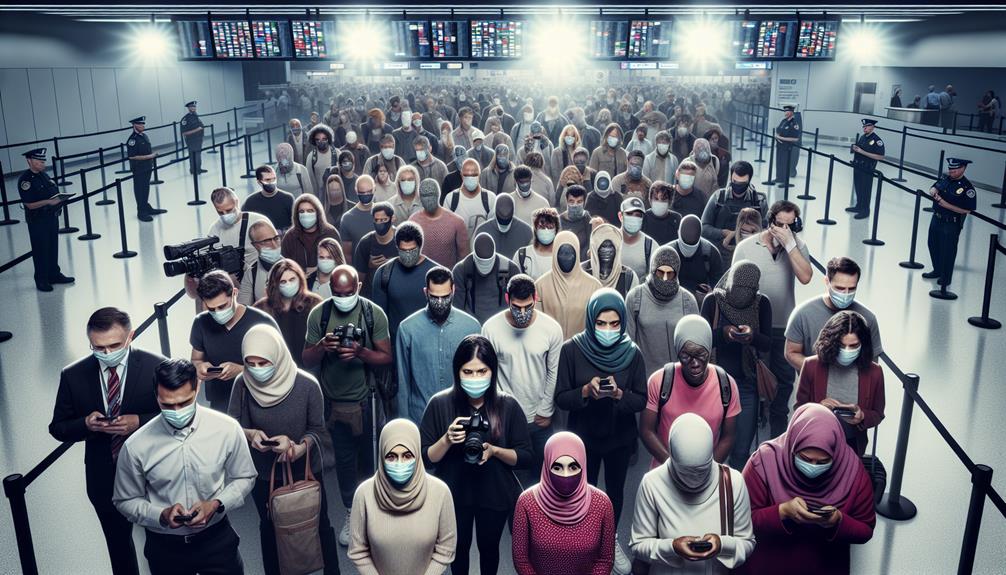
- Facial recognition systems have been implemented in airports like Paris-Charles de Gaulle and Paris-Orly to enhance boarding efficiency for over 100 million passengers annually.
- U.S. airports and European airlines have adopted facial recognition technology for boarding processes, showcasing its effectiveness in streamlining immigration and security checks.
- The Schengen Area is developing biometric entry/exit systems to strengthen border security, with EU-LISA working on a centralized system for recording entries and exits using biometric data.
- Facial recognition technology aims to regulate movements of non-EU nationals and enhance border control measures, with the system expected to be operational by 2022.
- National Australia Bank and Microsoft have tested facial recognition for cash withdrawals, emphasizing the potential of biometric data for secure and efficient transactions in various sectors.
Airport boarding procedures in both the United States and the European Union are experiencing a technological shift, with facial recognition technology increasingly being integrated into immigration and security checks to enhance efficiency and security. As a passenger, I appreciate the speed at which I can move through these checkpoints. This technology notably speeds up mandatory steps in the airport, giving me more time to relax before the flight rather than waiting in line. The accuracy and efficiency of facial recognition make it a prime candidate to streamline my travel experiences.
The introduction of facial recognition technology is ideal for both boarding and immigration processes. Segments like Star Alliance, with their decentralized facial recognition technology, enable a seamless and contactless journey. In Europe, Frankfurt Airport has implemented this technology for all airlines, providing biometric touchpoints from check-in to boarding. Integrating this technology into these processes enhances the overall travel experience by reducing wait times and improving security.
Safe and Efficient Transactions
Advancements in facial recognition technology have enabled secure and efficient transactions by accurately verifying identities in real-time, thereby minimizing fraudulent activities and enhancing financial security. As a result, this technology has transformed the way we conduct daily transactions, safeguarding the integrity and safety of our financial operations.
Biometric Authentication:
Facial recognition guarantees seamless biometric authentication, eliminating the need for passwords, PINs, or physical tokens.
Enhanced Security:
This technology provides an additional layer of protection against unauthorized access and fraudulent transactions.
Contactless Efficiency:
It streamlines transactions, making them faster and more convenient, while reducing the risk of identity theft.
Identification in Daily Life
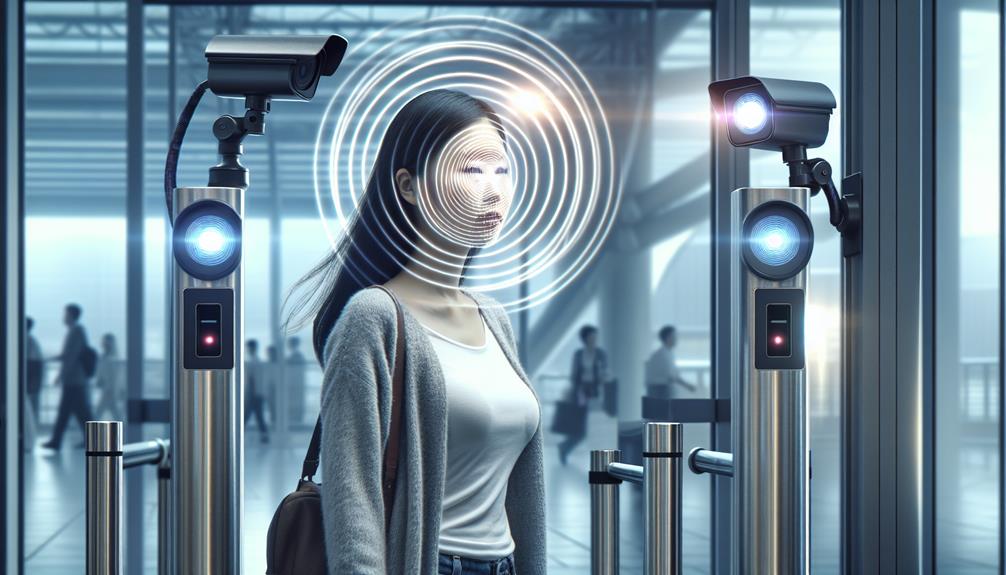
By utilizing facial recognition technology to swiftly identify individuals, we can streamline and secure access control within various industries, guaranteeing that only authorized personnel enter restricted areas. Many organizations, from law enforcement to supermarkets, benefit from the seamless verification process this technology offers.
For instance, facial recognition helps law enforcement agencies quickly match suspects against government databases, expediting the investigation process. In airports, it enhances security by identifying individuals on watch lists, securing that travel remains safe and efficient.
Moreover, this technology simplifies identity verification in everyday transactions, whether it be using Face ID on Apple devices or swiftly passing through airport customs. Facial recognition technology eliminates the need for physical credentials like cards or keys, making access control more convenient. It also ensures that authorized individuals can entry secured areas without the risk of unauthorized access, notably enhancing security measures.
In short, facial recognition technology plays a critical role in our daily lives, guaranteeing our safety and efficiency in various transactions and access control scenarios.
Maintaining Privacy and Ethics
When it comes to deploying facial recognition for perimeter security, maintaining privacy and ethics is essential.
To mitigate privacy infringement and potential misuse, I emphasize the need for robust biometric data protection measures and explicit consent guidelines.
This guarantees that individuals are informed about how their facial data is being used and minimizes the risk of identity misuse.
Biometric Data Protection
To safeguard users' privacy and maintain ethical integrity in facial recognition technology, robust biometric data protection measures must be implemented. This includes conserving and security biometric information from unauthorized access, data breaches, or misuse within biometric facial recognition systems.
Several measures are essential for maintaining this safety and regulatory compliance:
- Encryption and Secure Storage: Storing biometric data in encrypted, secure formats to prevent theft and unauthorized access.
- Regulatory Adherence: Ensuring consistency with regulations like GDPR and CCPA to manage biometric information legally and ethically.
- Biometric Data Management: Constructing policies for appropriate data collection, minimization, and accuracy, alongside ensuring data subjects' informed consent.
Consent Guidelines
Before collecting and processing facial data for perimeter security, it's essential that we obtain explicit, informed consent from users to guarantee their privacy and ethical considerations are respected. This consent is vital to address privacy concerns and confirm that users are fully aware of how their biometric data is used in security applications.
To maintain clarity and transparency in our consent guidelines, let's take a detailed look at what these requirements encompass:
| Guideline | Description |
|---|---|
| Consent for Data Collection | Users must explicitly agree to the collection and processing of their facial data. |
| Disclosure of Data Usage | We must clearly outline how the facial data will be used and for what purposes. |
| Periodic Review | Consent agreements should be reviewed and updated periodically to guarantee ongoing compliance. |
| Data Security | Robust measures must be implemented to protect facial data from unauthorized access or misuse. |
Minimizing Identity Misuse
By utilizing advanced algorithms and robust data security measures, facial recognition technology effectively minimizes identity misuse while maintaining privacy and adhering to ethical considerations.
This technology, employed for perimeter security, guarantees that only authorized individuals access secure areas, reducing the risk of unauthorized entry or identity theft. Additionally, it secures biometric data, abiding by strict data protection regulations to prevent any potential breaches.
To solidify its effectiveness, key aspects of facial recognition technology include:
- Robust Data Security: Advanced algorithms and encryption protocols protect the stored biometric data from unauthorized access.
- Transparency and Consent: The use of facial recognition technology is based on clear policies and user consent, ensuring that individuals know how their data is used.
- Ethical Practice: This technology prioritizes user privacy and security, adhering to ethical standards to prevent misuse.
Frequently Asked Questions
Why Is Facial Recognition Good for Security?
I rely on facial recognition for its biometric identification accuracy, enhancing perimeter security through AI-driven surveillance technology that swiftly matches facial features against authorized databases, preventing unauthorized access and ensuring a secure environment.
What Is the Purpose of Face Detection?
I employ face detection as the initial step in facial identification, pinpointing facial features in images or video streams. This surveillance technology enhances security by accurately and rapidly locating faces, even in crowded environments.
Why Is Recognising Faces Important?
'I emphasize that recognising faces is essential in identifying suspects quickly and enhancing surveillance. This accuracy in face detection technology secures high-risk areas and guarantees robust access control, making it an important aspect of effective perimeter protection.'
Why Should Police Use Facial Recognition?
I believe police should use facial recognition as it enhances law enforcement benefits, like swift suspect identification and surveillance effectiveness. It greatly improves public safety and response times during emergency situations, helping them proactively track known offenders.

